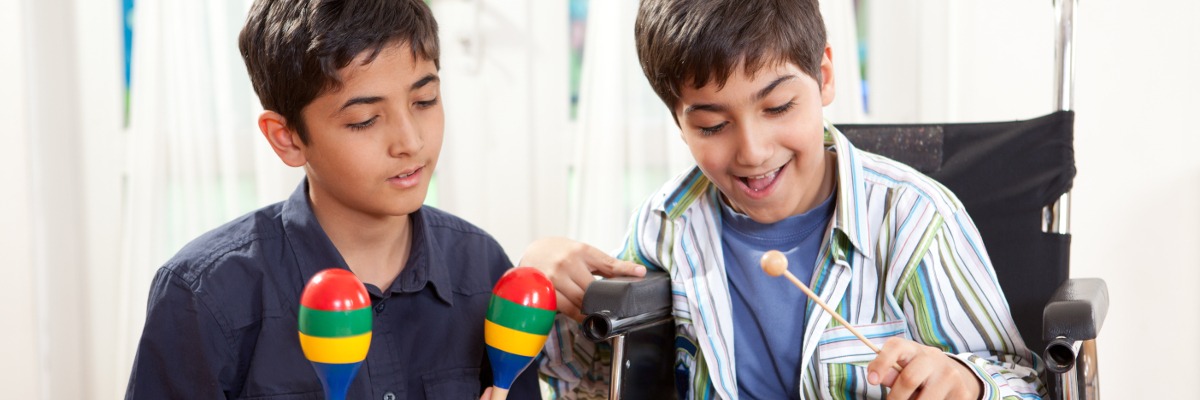
Music therapy is a common palliative for emotional and behavioral disorders. It makes intuitive sense that deep resonances, harmonious tones and gentle rhythms would have a comforting effect on the internal factors that cause psychological unease.
But over the past several years, many physicians and caregivers have been shocked to see the restorative effect that music has on the physical challenges that come with cerebral palsy.
Anyone living with cerebral palsy can tell you that the foundation of this disease is damage to the brain. When motor areas of the brain are affected by injury sustained during fetal development or delivery, the brain is unable to fully control the muscles of the body. The result is muscle debilitation, spasticity and/or loss of control. This can affect everything from movement and posture, to hearing and speech, to organ and respiratory function.
While many kinds of therapy are based on the principle of “a little more each day,” music therapists create therapy sessions that are openly “success” oriented. For children in particular, the reward system of being able to create a tone, mimic a rhythm or participate in a song encourages their effort and boosts their morale.
The Music Around Us
Music therapy is holistic in nature, offering unique help to the four main categories of how cerebral palsy affects the brain and body’s development:
- Cognitive: Learning disabilities and/or intellectual impairment are common symptoms of cerebral palsy. But music’s predictable patterns of intonation and rhythm allows music therapists to successfully use songs as memory aids for learning everything from the ABCs to more advanced concepts.
- Speech and Communication: Due to spastic motion and lack of coordination of the tongue, jaw and other muscles, cerebral palsy patients may stutter, lack fluency, and experience voice disorders. Music therapists who partner with speech therapists have been shown to enhance the effectiveness of receptive speech skill work. Techniques based on musical rhythm provide patients with a structure for producing verbal responses, which helps to develop better fluency and rate of speech. And vocal/singing lessons have been successful in helping patients control and moderate volume, breathing and pitch.
- Motor Skills: The cerebral palsy patient’s difficulty with walking, maintaining balance, or fine motor tasks (such as writing or using scissors) is one of the foremost areas that music therapy can help. Practicing a musical instrument allows patients to exercise muscles by strengthening, stretching and improving motor skills. The concrete goals offered by an instrument’s specific range of motion (such as reaching multiple keys on the piano or strumming guitar strings) offer a built-in reward system for the patient, and the daily routine of practicing music is also helpful in structuring and guiding the therapeutic process.
- Social: Individuals with cerebral palsy can be prone to self-isolate, due to their limitations in participating in commonplace activities. Music offers a social environment that admits many different abilities and skill levels. Interactive songs help patients adjust in appropriate social interactions. Gradually they refine eye contact, facial expressions, turn-taking, and other important social skills.
Other areas that music therapy can help with include:
- Decreasing pain perception
- Improving decision-making skills
- Increasing ability and manner of expressing feelings
- Creating opportunities for choice and control
- Improving self-esteem and a sense of being “normal”
The Power of Music
So how does music offer all this therapeutic power? The answer might create skepticism when compared to real, hard-and-fast science — it is due to the transcendent nature of art, and how it appeals to the human psyche regardless of age, culture or ability level.
Simply put, music’s emotional and psychological effects make it a medium in which the body is able to both relax and flourish. Proof of this was offered in a 1985 study in the Oxford Journal which found that “expressive modalities [such as music] enable the children to use aesthetic experiences to find pleasure, emotional release, mental stimulation, and personal satisfaction—all of which take them beyond the confines of their disabilities.”
The unique power of music to foster a sense of beauty that transcends circumstances can make the difference between a patient that grows frustrated and gives up, and a patient who makes real progress in creating a life of joy. Music can be the positive turning point in a cerebral palsy patients’ therapy development.
Marcella DeVivo, a freelance writer and parent of a cerebral palsy patient, wrote this glowing testimonial about how music therapy has dramatically affected her son’s physical and emotional progress development:
“While my son has little control over his own body and motor movements, he is cognizant and is actually very aware of everything around him. He may know that he wants to move his hand or grasp something, but actually doing it is a completely different story.”
Nathan’s music therapist works with him so he can play guitar by positioning the instrument in a way that allows him to strum along and feel like he’s actually making music and creating something. He may not have perfect control, but it involves him in the process and gets him moving in a positive, constructive manner.
“Perhaps the most significant thing music therapy has done for Nathan is to help improve his emotional state. Listening and being involved in music makes my son so happy. Through music therapy, the gap between his mind and body has been partially bridged.”
For cerebral palsy patients, anxiety, frustration and self-consciousness foster muscle tension that dramatically sets back physical progress. The relaxation, excitement and elevated morale that a cerebral palsy patient experiences in the presence of music is often the “secret sauce” that finally allows muscle resistance to subside and effortlessly motivates endurance.



